Media | Articles
How Chevy’s Retro-Wild SSR Came to Be
In all our many years of attending Michigan State University home football games, we have never seen such a reaction to any vehicle in our (or any) stadium parking lot. Not even to the borrowed Rolls-Royce press car with which we once tailgated some years earlier. Our reserved spot was close to the stadium at an intersection of two heavily traveled walkways, so a lot of folks passed by before the game. And a truly surprising number—from youthful students and cheerleaders to old-fart alums—stopped and gawked and asked about our unique, eye-popping vehicle. Was it a Ferrari, a Lamborghini, an Aston Martin, a Bentley GT? Something even more exotic? Nope. It was a shiny black early-production Chevy SSR.
My wife, Jill, was communications director for GM Product Development at the time (when Bob Lutz was running that group), and her boss had offered her the SSR for the weekend. It was a few weeks before that retro-rod convertible truck had hit Chevy dealerships, so almost no one had seen one even though they were being built just down the road in the same Lansing Craft Center that had assembled GM’s EV1 electric car and Buick’s Reatta two-seater.
I had just finished an Automobile Quarterly book (SSR – An American Original) on that custom-look truck so had interviewed and learned about it from everyone who had worked on it. And I spent virtually all my pre-game time talking about it and answering questions. Why did it look like a chopped and channeled 1950s pickup? What was under its low, sweeping, retro-truck hood? How did it drive? How did its unique retractable hard top work? I fielded a bunch more, including from some players and coaches, after the game, too.
How It Happened
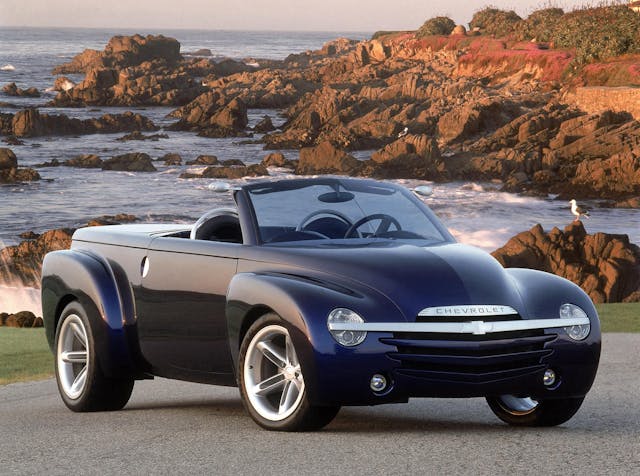
The SSR (Super Sport Roadster) was born as one of a dozen concept vehicles (including three from Chevrolet, one from Germany’s Opel, a soon-to-come Hummer H2 and the 80-mpg Precept prototype from GM Advanced Technology Vehicles) displayed at the 2000 Detroit North American International Auto Show. All 12 looked good, some great, but the SSR stood out. Hunched low on aggressive five-spoke alloys wearing fat performance tires under wildly flared fenders and powered by a high-performance 6.0-liter V-8, it looked sleek and muscular and promised driving dynamics more sportscar than truck. Everyone loved it.
This idea had been in then-GM Design VP Wayne Cherry’s head for a while. “My vision was to create a modern interpretation of the early 1950s classic pickup that has become the quintessential choice for street-rod custom trucks,” he wrote for the Foreward of my AQ SSR book. “I believed there was an opportunity to build upon that legacy in a new way.”
Marketplace
Buy and sell classics with confidence
Cherry had set up a special SpeedVision studio, GM’s first to use computers instead of drawing boards to develop new designs, then evolved it into a Corporate Brand Center (CBC) under then-executive designer Ed Welburn. “It was May 31, 1999 when Wayne invited me to sit between him and Ed to hear his ideas,” recalled Brian Baker, who was managing that CBC studio at the time. “As was my practice, I sketched during the discussion and showed my first impression to them as the meeting ended. They gave us the green light to start sketching.”
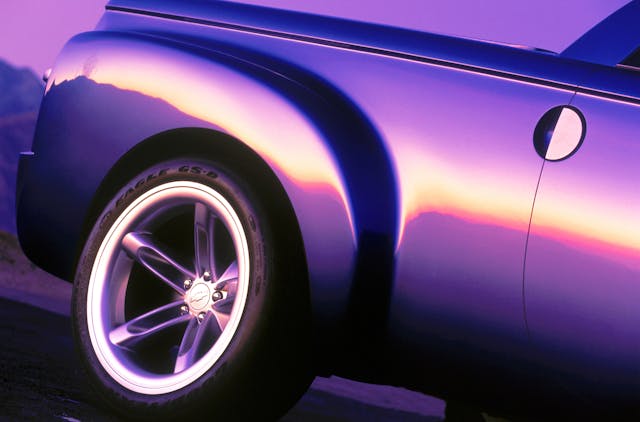

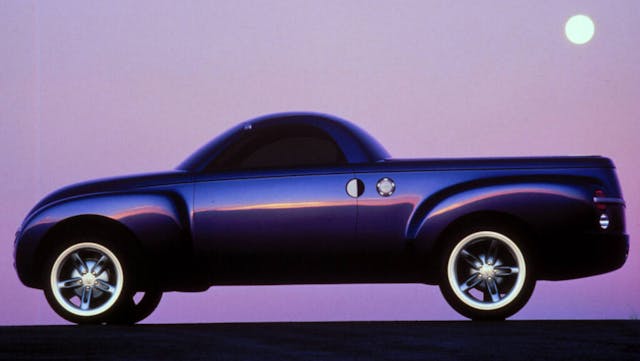
Moving very quickly, the studio developed multiple themes—both “slammed” and lowered, and sitting up high like an early ‘50s truck. A lowered “slammer” design with large, flared fenders became the top candidate. “We had no clay models in this studio,” Baker related. “We relied on digital math models, projected them on a massive screen in our Virtual Reality Room, and viewed them through 3-D goggles. And we brought in ASC, and later Karmann from Germany, to figure out a two-piece retractable hard top that would not take up cargo space.”
When they earned approval to build full-size foam models, no shop in the Detroit area had capacity to make them due to other work for the 2000 Detroit Show, so they contracted Metalcrafters in California. “Glen Durmisevich smoothed Dave Schick’s digital surfaces for a terrific-looking model,” Baker continued. “Huge chrome tailpipes and high-mounted ‘hot rod’ mirrors completed the ‘California billet’ look.” They envisioned the production SSR on a low-riding Cadillac sedan chassis, but it would end up taller and 10 percent bigger than the concept on a shortened three-row Trailblazer SUV frame. “Still, Bill Davis and Glen Durmisevich did a great job of keeping the religion of the concept as they productionized it.”
When they pulled the cover off their “slammer” model In a September GM North American Strategy Board (NASB) new-product review, that group was stunned. “This was the top leadership of the company,” Welburn related, “and they were very excited. We had a monitor setup with a simple animation. It rotated, then the top went down, and that really got them going. They asked, ‘Can we do this for the Detroit Show?’” Cherry and Welburn exchanged looks. They had not engineered it at all nor even thought about building it for Detroit. “Sure,” Cherry said. “Yes… we can.” The program had moved from initial sketches to two full-size foam models in an incredible seven weeks, all done in a totally digital environment. Now they had just three months to build a running concept vehicle with a working retractable hardtop.

Technical Staffs and Truck Engineering group executive Tom Davis (no relation to designer Bill) and then-Chevrolet general manager Kurt Ritter put together a team that worked long and hard to find a way to get it done. “We told Engineering to get with Design Staff and figure out how we could do this on an existing chassis and Manufacturing to figure out how we could build it somewhere in the company,” Tom Davis recalled. “This was going to be a home run. The issue was how can we do it at a cost and a price level that makes sense.”
Designers Bill Davis and Glenn Durmisevich worked with the Portfolio Development Center (PDC) on the production design using as many existing “carryover” parts as possible. While the concept had been quickly built on an S-10 compact pickup platform, the production proposal was to be built on the soon-to-come GMT 360/370 Chevy Trailblazer midsize SUV architecture that would provide room and structure for a V-8 engine and a 25-gallon gas tank. The standard Trailblazer platform’s wheelbase was too short to achieve the right proportions, so they put it on the longer three-row chassis cut down to just the right length.
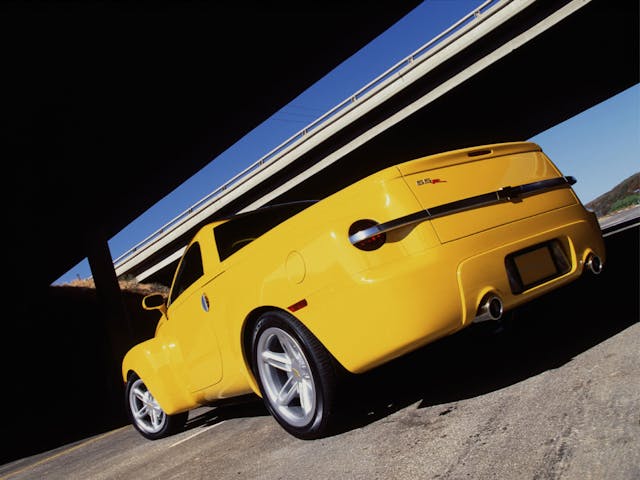
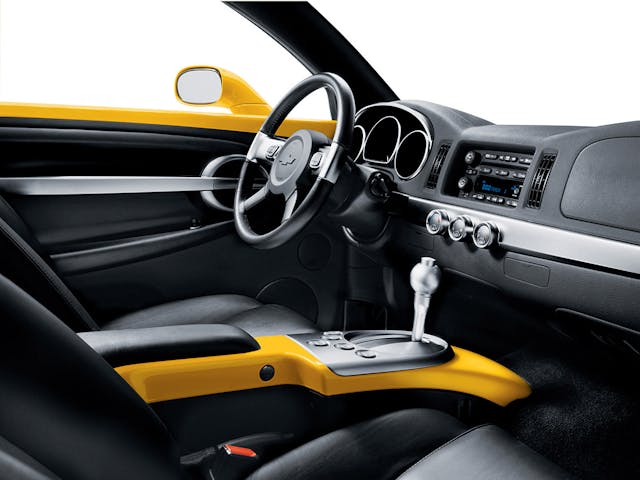
On August 9, 2000, just seven months after the SSR concept truck had wowed everyone at the January Detroit Show, then-GM CEO Rick Wagoner announced at the Traverse City, MI Center for Automotive Research (CAR) Management Briefing Seminars that GM would build the SSR beginning in late 2002. Then he and Ritter proudly paraded the purple/blue concept SSR in the August Woodward Dream Cruise—the annual auto extravaganza that lines suburban Detroit’s famous Woodward Ave. with thousands of enthusiasts ogling a mind-blowing variety of collector cars and trucks cruising by.
Then, on Sept 5, NASB reviewed the results of a 14-week production study and approved the continuation of the program and selection of ASC as the primary outside partner. But developing the production design on the GMT 360/370 midsize SUV platform was a major challenge. To meet crash requirements with some 70 percent carryover parts content, it had grown longer, wider and taller and had lost the concept’s pleasing proportions. Everyone soon realized that this modified design wasn’t working, and some say it nearly killed the program.
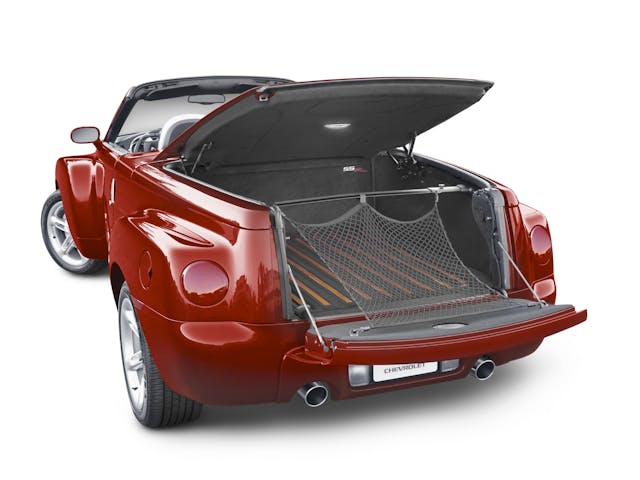
So, working in a small ASC studio across from GM’s Warren, MI Tech Center, the combined GM/ASC team embarked on a different approach. “We still started with the 360/370 chassis,” ASC Creative Services president Mark Trostle said, “but took it to another level with a new floor pan, a new cowl, and all-new sheet metal. And we had to stretch the front overhang about four inches to work around the chassis components and for crashworthiness.”
The build team worked with Visioneering Technologies on the retractable hardtop design, which was demonstrated and approved on October 15. Operating through two separate mechanisms, it folded, retracted, and stored vertically between the cabin and the bed, exactly like the animation that had so excited the NASB. And when Wagoner drove a yellow production-intent version in the 2001 Woodward Cruise, a spectator yelled to him, “It’s a great truck, but you’ll never build it!” “Oh, yes, we will,” he yelled back. “You just wait.”
In January 2001, then-GM Manufacturing VP Gary Cowger announced that the SSR would be built in the small, specialized Craft Centre plant in Lansing, MI because of that facility’s “proven history of producing high-quality, low-volume niche vehicles such as the Buick Reatta, EV1 and Cadillac Eldorado.” Among the many challenges was the widely flared steel fenders, which required a specially developed stamping process to achieve a huge 18 inches of “draw” for the fronts and 10 inches for the rears. The first salable SSR rolled out on July 29, 2003.
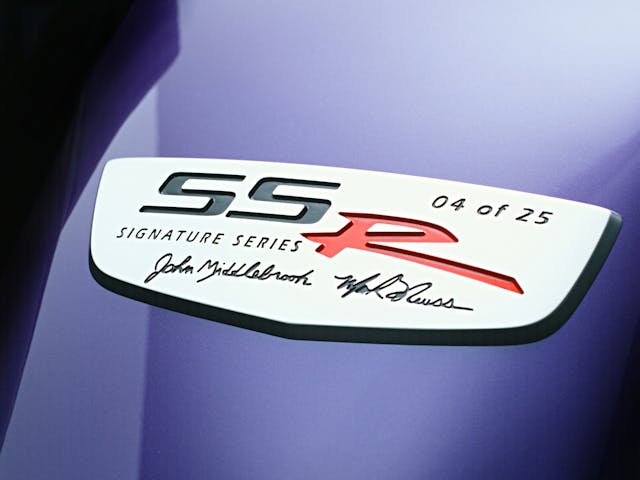
One interesting sidebar was the 25 early special-build Ultra-Violet “Signature Series” SSRs (VINs #0001-0025) that were autographed by GM executives, designers, engineers, and builders then sent through a series of events and celebrities to build collector desirability and value, then sent to auction with autographs, photos, news clippings and other memorabilia documenting their unique journeys in special scrapbooks inside metal pedigree boxes. Another was the specially prepared SSR that paced the 87th Indianapolis 500 on May 25th, 2003, preceded by a media reveal of all 25 Signature Series SSRs when reporters enjoyed the opportunity to cruise them around the Indianapolis track with Indycar drivers riding shotgun.
Our SSR
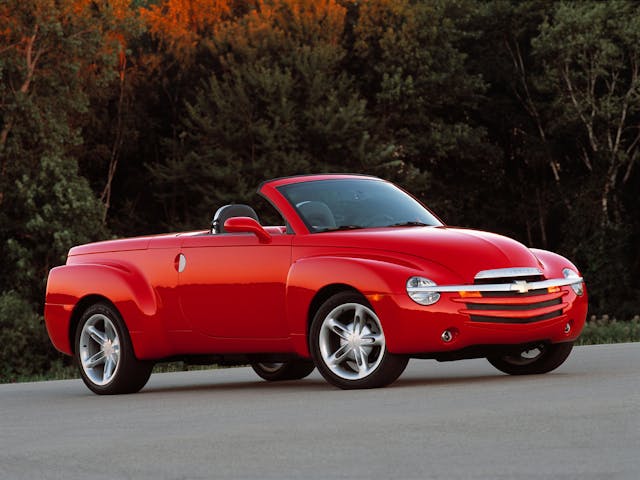
After that MSU tailgating experience, Jill suggested that we really should have an SSR, and I eventually agreed. We had no time, budget, or energy for old cars at the time, but how about a very cool new one covered by its full GM warranty? I had enjoyed two media track test opportunities in SSRs and had found them surprisingly athletic and fun to drive despite their size and weight, largely due to excellent chassis tuning by the very capable dynamics development engineers and partly to massive traction from their huge wheels and tires.
We applied for a “Captive Fleet” SSR that had served as some lead engineer’s or executive’s company vehicle for several thousand miles. That program put sufficient numbers of early-build new vehicles out in daily usage to catch and fix any last-minute glitches before they began being shipped to dealers. They were then offered to employees and retirees (using a lottery system if there was more demand than supply) at friendly used-car prices. We got a red one.
My memories of driving that bright red SSR, especially with its top down, are all good. It did ride and handle surprisingly well, and I loved the sound of its low-restriction dual exhausts, both when idling and under power. It also had plenty of performance for casual cruising (~7.7 sec. 0-60 mph), though the media bashed it for packing the standard 300-horse 5.3-liter SUV V-8 and automatic transmission (because that powertrain was emissions-certified) instead of the 2000 concept’s much more powerful 6.0-liter Corvette-derived engine.
We enjoyed ours as a big, head-turning, two-seat roadster with a giant covered trunk. I fondly recall cruising it home from a media event at the Automotive Heritage Museum in Ypsilanti, Michigan one warm summer evening. Jill had just picked up the Captured-Fleet 2006 Pontiac Solstice we had ordered and had driven it there to join me for dinner. With the SSR’s top down and those lovely exhausts burbling happily at freeway speed, I watched our new Solstice in my mirrors and thought these were two of the coolest-looking cars on the road, both new, factory-warranted and potentially trouble-free, not old and potentially needy.
Two model years too late, the SSR did get substantially quicker for 2005 with the C6 Corvette’s 6.0-liter LS2 V8 (with 390 hp in this guise) and offered an optional six-speed manual transmission for the first time. Performance with the manual improved dramatically, to an advertised 5.29-second 0–60. It got five more ponies for 2006…then was abruptly canceled due to weak sales.
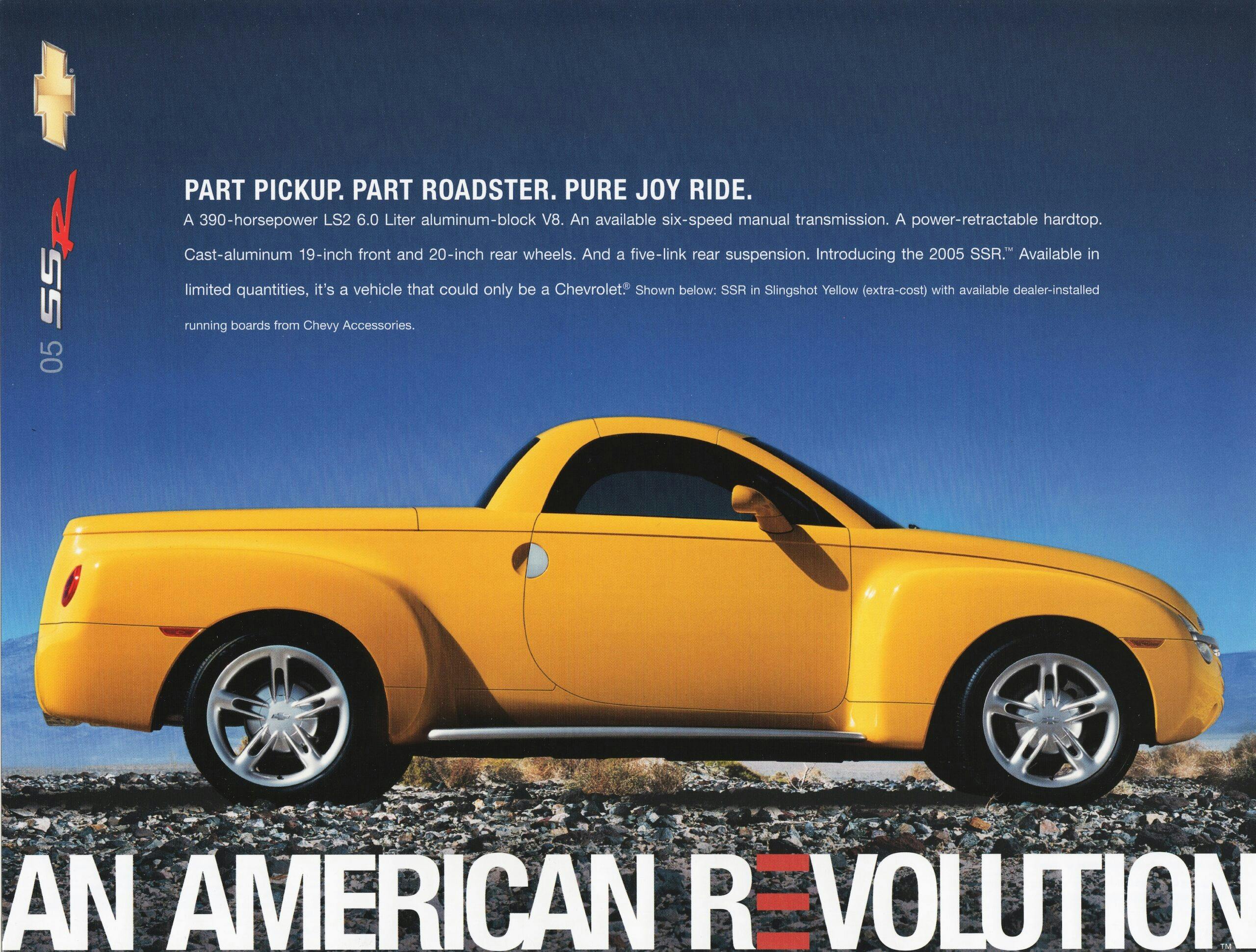
Reports vary on how many SSRs were built and sold between its mid-2003 launch and its mid-2006 cancelation, but this hot-looking retro pickup proved a sales disappointment. According to carsalesbase.com, just 1,664 were sold in calendar year 2003, 9,648 in 2004, 8,107 in 2005, 3,803 in 2006, 244 (remaining 2006 models) in 2007 and the last 13 in 2008. That adds up to 23,479, though other sources contend that total production was 24,150, of which 24,112 were available to the public. Counting those 25 Signature Series trucks, make that 24,137.
Why did this super-cool pickup fail in the market? On the positive side, its sexy retro-rod looks, rumbling exhaust, and surprisingly athletic handling made it a smile-inducing cruiser, especially top-down. But it was too big, too heavy, and too pricey at more than $42,000. It also wasn’t as quick as most expected it to be, at least in its first two model years, due to the GM truck V-8 and four-speed automatic transmission it initially inherited from its Trailblazer SUV cousin.
After acquiring our 2006 Solstice, our ‘03 SSR had to go, eventually to a friend of a friend in Arizona who had previously owned one, then sold it, then wished he hadn’t. Looking back, the SSR still looks great, it was fun to drive, and its rarity predicts good collector value.










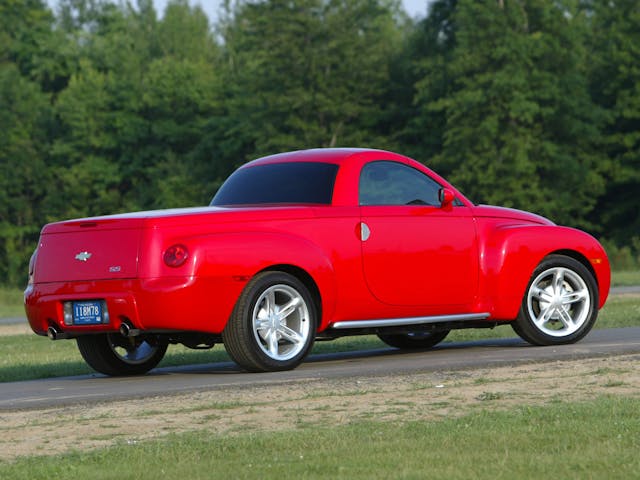
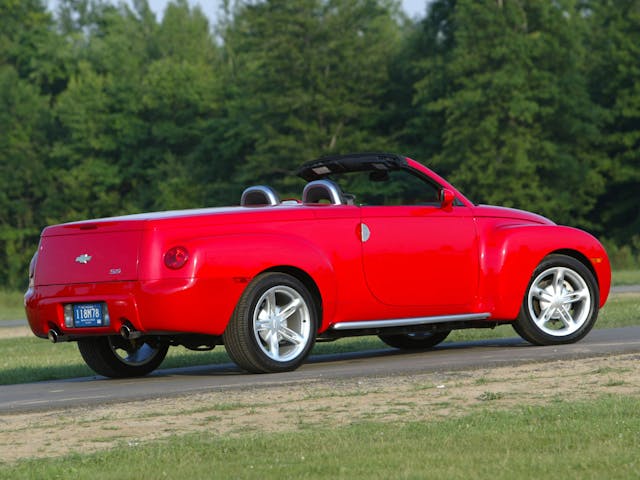















I knew a guy who had one of them. He was a old-school, big power rodder type, and when he showed up for a cruise in the little red truck one day, I thought he’d gone nuts. But it held its own, even among some pretty fast muscle, and it was definitely an attention grabber.
One of my oldest friends who retired from GM had two red SSR’s. One in Michigan he kept at his Michigan home. Then bought a second to keep at his Florida home. Sad to say he died not too long after he bought them, left them to his two sons.
I followed the SSR from early on. I liked the idea.
The first on I saw may be the Yellow one here. Scott Settlemire brought one into where I worked well before they were at the dealers. I agree it could easily draw a crowd.
I also was at Detroit when the concept was shown.m
Bob Lutz worked really hard to bring excitement to Chevy and Pontiac after losing the F body with no plant to replace them.
He pushed the SSR, GTO and later the Sky, Solstice, HHR, Trailblazer SS and V series. He wanted to bring attention to products but lack the money and time he really needed. So each one of these cars are a miracle they made production.
The yellow SSR I first rode in Scott had was nice but he pointed out the Ergonomics like seat adjustment were best if the door was open. I noted later while auto crossing one it had significant frame flex if pressed.
And parts bin parts were from many GM cars including an Alfa Romeo GM owned at the time.
I like these and almost thought about buying one twice.
The issue that killed it is what Gary stated here price. $42k back then was Corvette coupe money.
Now if it was smaller and had a 3800 SC in it priced around $29k it may have done better. It did not need a fancy bed and it could have replace the ZQ8 package on the Colorado. But there still may not have been enough money made at that price.
Either way by the end on this truck the Camaro was being pushed by a group in GM and Bob took up that cause to get the Zeta platform built and even planned a new GTO that remained still born.
The one thing here is I think the HHR would not have come had the SSR never made production. It was priced right and contrary to the critics sold in six figures for most of its life and made a lot of money. Even 12 years after the last was built many are still on the road. It was basically a Cobalt wagon and there is no way they would sell over 100,000k wagons a year as a Cobalt. So the SSR may have really brought in more buyers than just the models it sold.
It was an interesting time as GM had no real plans for cool car with Lutz coming in right after the Aztek came out and losing their F body as it would not pass crash test and they did not have the money to replace it based on sales volume. Things did not make sense but if you factor in some things we now know it is amazing they got these cars done.
Even the mid engine Corvette was being worked on right after the SSR but it was delayed so it could be done right so we got the C7.
I thought these were interesting but it seemed the interest in these things did not last long. In my area it seemed the 1st year maybe 2 were the highpoint after that they slowly disappeared. It was something different but a convertible truck isn’t going to be a long term seller.
I never got the draw to these. Seems like just a nostalgia play for those people who were kids in the 50s. Which is probably on point. I haven’t run into an owner who wasn’t under 65 and the stereotypical grumpy old codger who sits behind their car at car shows with a time out kid as part of their display.
Sample size is limited, but is consistent.
Tell me how you REALLY feel about guys like me without telling me how you feel about guys like me…😜
I guess I am one of your “old codgers”. After owning eight 57-70 Vettes and found it was miserable trying to egress my 70 – 454 – 4sp Roadster I had built ground up. I already owned my 2 SSR’s and felt they were solid replacemens, same drive train and a trunk. I love my 450 hp 6sp 2006 FPR SSR. True, I sit behind it, but my knees prohibit me from walking about and telling you your POS is nice. I don’t grumble, I speak with pride and knowledge. I miss the grumble of the 454 on start up. If I were your father I would be angry for your lack of respect. You will get here!
Respect is never given, it is earned. Something my father taught me.
I wouldn’t say it’s never given.
Another oldee. I was 55 when purchased my ’05 red SSR from Chevy Test Track Showroom, EPCOT, Disney
World, FL. Prior 2 Vettes, 2 Suburbans, I thought this had some good power, 2 seating (6’5″, I fit well in it, after getting in), of a Vette, and more storage (not nearly that of my Subs’). Now, retired Disney, driven a few times mo, and daily, summers in New England, have 221k mi, runs like a top. Spent scads, over the 20 yrs replacing all mechanicals/electronics, except the engine (thank you Amsoil), and stainless steel exhaust. Best mechanic in Orlando, specializes in auto electronic repairs, knows the SSR like nobody i know. It will still do 140, no problem. I wouldn’t buy any other vehicle to replace this.
We love our 05 also. With your comments on electrical maybe you could shed some light on my problem. For it to start I must put the key in the door and turn it to lock then unlock. The ignition will crank then start. 5-10 seconds later it will shut down. I then repeat this process. No it is not out of gas and it is a new battery. What in the world does this system have that has to deal with the door key? Thinks it is being stolen? or could this be the computer brain? We trailer a teardrop camper and it really gets the attention. Live in Iowa on the Mississippi. Been to FL., Maine, Casper, Wy twice. 65k miles. Fun car. Several car shows and always a favorite at the Tearjerkers camper club rally’s when we can get away. Your feedback would sure be appreciated. Thank you in advance.
I have 05 Asphalt w 19,000 miles. Recently pass window quit working, coincidentally top would not work. Repaired the widow power. Top still not working?
Looking for advice.
Oldsmar, FL
While working for a contract testing company in Troy, did some in-lab durability testing on the SSR. Found only a few incidents, and all were immediately addressed and retested.
I’ve had 2 SSRs, first a 2004, currently a 2005 Aqua Blur, love the retro look and the top down cruising. Previously had a C7 Vette, great car but back issues made ingress and egress tough. The R sits higher, has much more room, is plenty quick and a retractable hard top . What more can you ask for? Re: the HHR , I have a 2009 HHR SS as a daily driver, also a fun ride!
The HHR SS is one of GM ‘s best kept secrets. I hated FWD and I hated Turbo engines. I was not a HHR fan till I was tossed the keys to a HHR SS. I was in second gear going to 3rd gear and was at 90 MPH already.
I needed a small hauler and hated the first Gen Colorado. So I bought the SS. I loved it for 10 years. Most thought I built it and the Mustang guys would ask what I did to it when I would run door handle to door handle with them. All I had was the the GM tune. I never had an issue with it over 10 years and had a need for a truck so I had to sell it. I got over 50% of what I paid for it after 10 years and few daily drivers will do that. It will be a collector cult car in the future as so few were made.
Often it is the cars people find odd when new that prove to be cool later. Anyone heard about the Superbird. It took years to sell them off and now people fall all over to buy one. Tucker?
Like any car there are those who like them and those who don’t. Also in this case there were those who could afford a truck you could not really use for work and those who couldn’t.
I liked it and was well under 65 years old but for that kind of money there were other cars that I would rather have. If it were $29K then I may have been in the market to buy.
My friend Robby races a blue C5 Corvette and tows it on an aluminum trailer behind his matching SSR. It’s a pretty sweet combo!
Just picked up a Slingshot Yellow ’04 with only 12,300 miles on it. Dream car come true. Like a 17ft-long Hot Wheel toy. I’m in love…
Hi Gary, so happy to hear of your continued involvement with the SSR. My username on SSRFanatic is “Cash”. From day one I was fascinated with the SSR. Even though I had owned many Vette’s I realized so much had been written about them I had nothing to add to their legacy. However, with the SSR, no one had followed their history after 1st Production, July 29, 2003. I decided to tackle that nbut did not think my next 16 years would be doing that. Your “SSR, An American Revolution” was, and still is my SSR Bible. I look after Ther Heritage Forum and so much more. You have stated some things in this note I did not know. We had original drawings by Glen Durmisevich on a diner napkin, but it sounds like he did modifications to an earlier drawing. I would love to chat with you to get your interpretation on a few things – ssrfpr@gmail.com
In 2000, I was a journalist working as a writer for GM at the North American auto show in Detroit. They introduced the SSR concept at that show, and we were particularly impressed.
About seven years later, I crossed paths with an SSR again. I have been an Indy 500 pace car collector for quite some time. Noted Ohio car collector and dealer, Bob McDorman, was selling off his collection.
I purchased the 2003 SSR Signature Series pace vehicle (VIN 00004) from Bob at that auction. I restored the original strobes, belts, and fire extinguisher to the SSR, returning it to it’s condition on Indy race day, 2003.
The next few years, I took the truck to Detroit, and joined the folks from SSRFanatic.com at the Woodward Dream Cruise, and had a great time.
My SSR also participated in several Indianapolis 500 supporting events over the years.
It has moved on, but I enjoyed the truck a great deal. A real conversation starter and a fun driver.
i worked with a guy who was a gm field rep at the time the ssr was in development. like this article states, the fenders were a real challenge. any designer & engineer that was around when large bulging fenders were in vogue, mid 50s maybe, were no more. and the knowledge to design and build those fenders went with them. sorry, i don’t remember if he gave specifics of overcoming the process. imo, that info probably wasn’t kept due to costs, not legal or records retention issues.
GM was just starting to make odd sheet metal and C5 frames with Hydroforming. It can make deep panels with out the metal splitting. Also it will be stronger.
Today Hydroforming is still in use and very common.
I owned a loaded Yellow 2005 SSR 6.0 with an automatic transmission for about 3 years. I loved that truck. I wanted to keep it for my retirement years, but I had to let it go. That was a sad day.
I still have my bought-new red 2004 SSR with only mid-40s mileage. Always thought it was a great car and concept. I wan’t surprised it didn’t have the sales to stay in production.
Right now, I’m looking for a good mechanic to help repair some mouse damage to my SSR’s electronics, but otherwise it’s still in great shape. I’m in RI if anyone has any suggestions.
Check out the SSR Fanatic group on Facebook or the SSR Forum for referrals to help with repairs
My smokin black asphalt 2005 six speed was awesome especially for those day trips down da shore but eventually as I say everything is for sale except my wife and pups lol so a Chevy dealership bought it up as their parade vehicle and it lives a good life